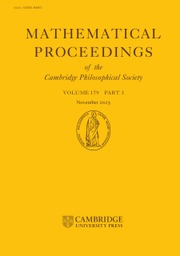On Euclid's algorithm in real quadratic fields
Published online by Cambridge University Press: 24 October 2008
Extract
The object of this paper is to complete the proof of the
Theorem. Let P(√d) be the quadratic field of discriminant d > 0. Then Euclid's algorithm does not hold in P(√d) if d is sufficiently large.
Information
- Type
- Research Article
- Information
- Mathematical Proceedings of the Cambridge Philosophical Society , Volume 34 , Issue 4 , October 1938 , pp. 521 - 526
- Copyright
- Copyright © Cambridge Philosophical Society 1938
References
† Kungl. Fysiogr. Sällskapeti Lund Förhandlingar, 5 (1935), 5.Google Scholar
‡ Journal für Math. 174 (1936), 192–205.Google Scholar
§ Journal London Math. Soc. 13 (1938), 3–8.Google Scholar
∥ We say that u is a quadratic residue mod v in the naive sense, if the congruence y 2 ≡ u (mod v) has a solution.
† Vinogradov, , Trans. Amer. Math. Soc. 29 (1927), 218–26Google Scholar proved ![]() His proof is easily generalized to obtain Lemma 3. See also Erdös and Ko, loc. cit. Lemma 3.
His proof is easily generalized to obtain Lemma 3. See also Erdös and Ko, loc. cit. Lemma 3.
† It may, of course, happen that a 1 and a 2 are both residues.
- 6
- Cited by

